What a crazy last couple of days. The winds were so strong and visibility was so poor that we could not access the site for a day and a half. We had a power outage early this morning, so diligently tried to get into the site since the winds had subsided. It took almost 3 hours to plow the road to the site because of all the snow that had drifted over the last couple of days.
Once we got to the site, it was quite cold. Since the power had been out for about 9 hours, the heat was not pumping in the facility. I quickly assessed the samplers and fixed them once the power had turned back on. I also had to fix one of the inlets to the sampler because it was packed full of snow. It only took me about 3 hours to get everything up and running correctly again!
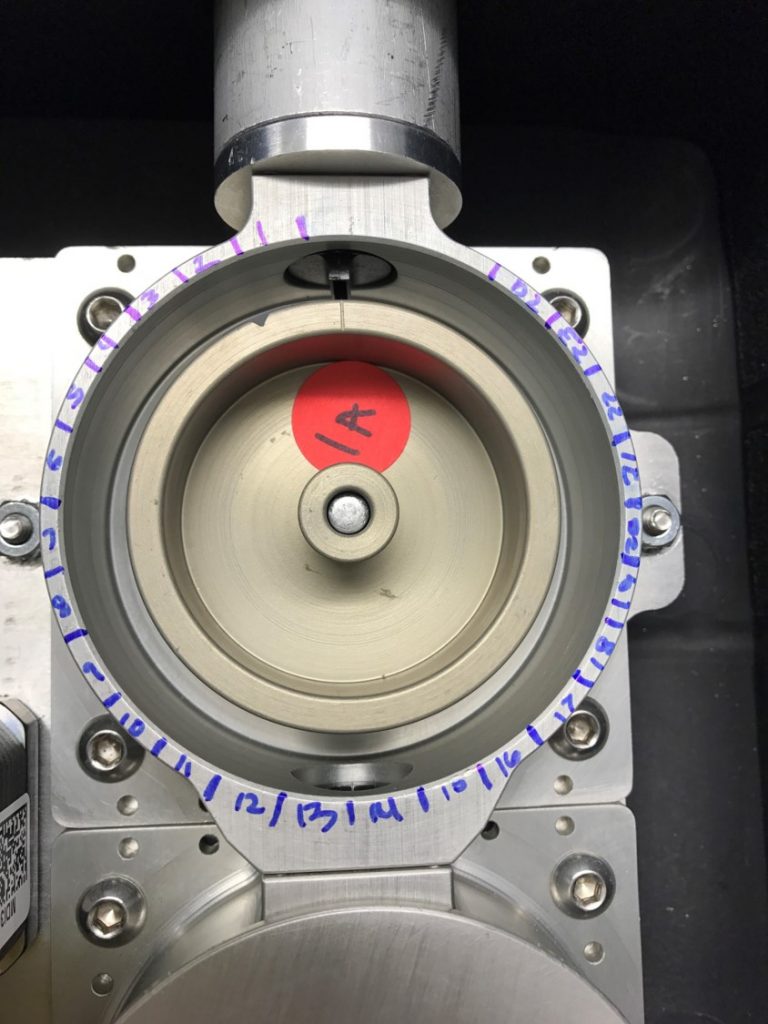
This is what part of the inside of my sampler looks like. That disc has what is called a “sample substrate” wrapped around it. It is basically a very thin strip of plastic that has a sticky surface that enables aerosols to adhere to it. The disc rotates slowly over time as air is pulled into the circular chamber through a very small slit in the tip of it. As a result, aerosol particles are “impacted” on the top of the disc. Since the disc rotates, I get a timeline of collected aerosol particles to use in my lab back in Boulder, CO for analysis. The plan is to conduct a type of analysis that tells us if the aerosols are good or bad at impacting how ice would form in Arctic clouds.
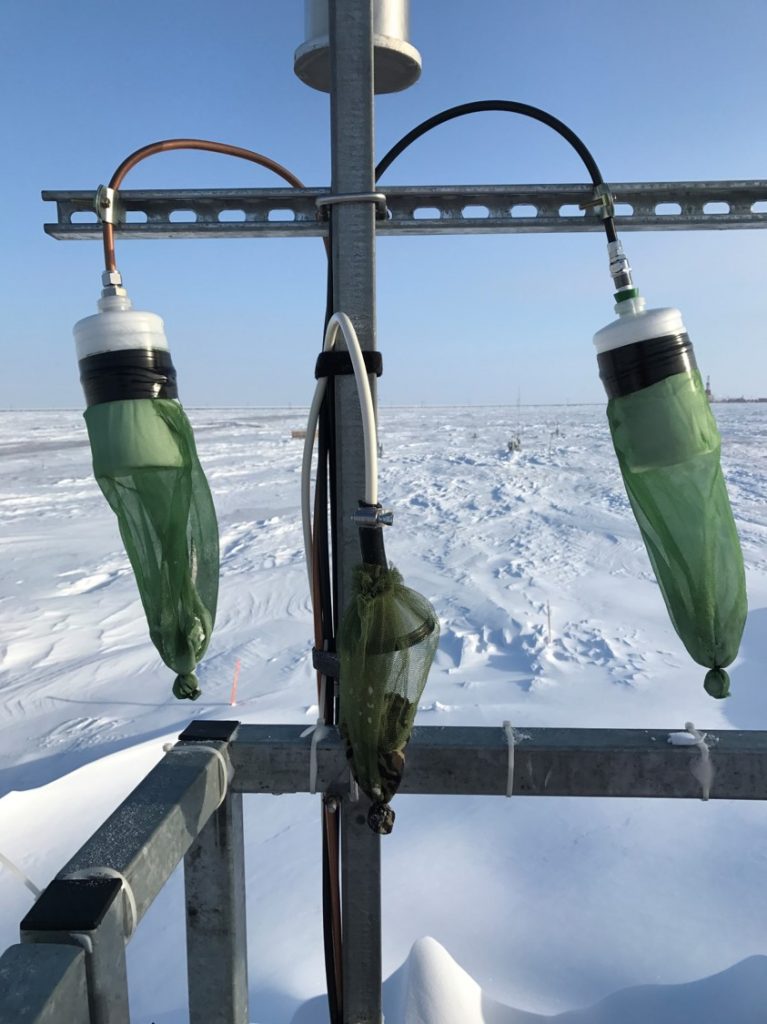
These funnels covered in green netting, and the silver can at the top of the photo, are the inlets to the different samplers I have running inside. Basically, a strong vacuum pump is pulling air to the samplers, through tubing that connects to these inlets. That air that is being pulled in through this system contains aerosol particles, so tiny that you cannot see them with the naked eye. The inlets look like this to prevent snow and ice from getting into the samplers. The green material is actually mosquito netting. These inlets blow around in the cold wind, and the netting prevents ice from building up and clogging the inlets.
Even though there were issues with the power outage, everything worked out and it turned out to be a beautiful Arctic day. The temperature reached up to 0 degrees Fahrenheit and there were almost no winds, what a treat! I took the opportunity to take some photos of the site, and with “Harold” at the entrance of the camp 🙂 To top it off, it was cheeseburger night at the mess hall, YUM!!
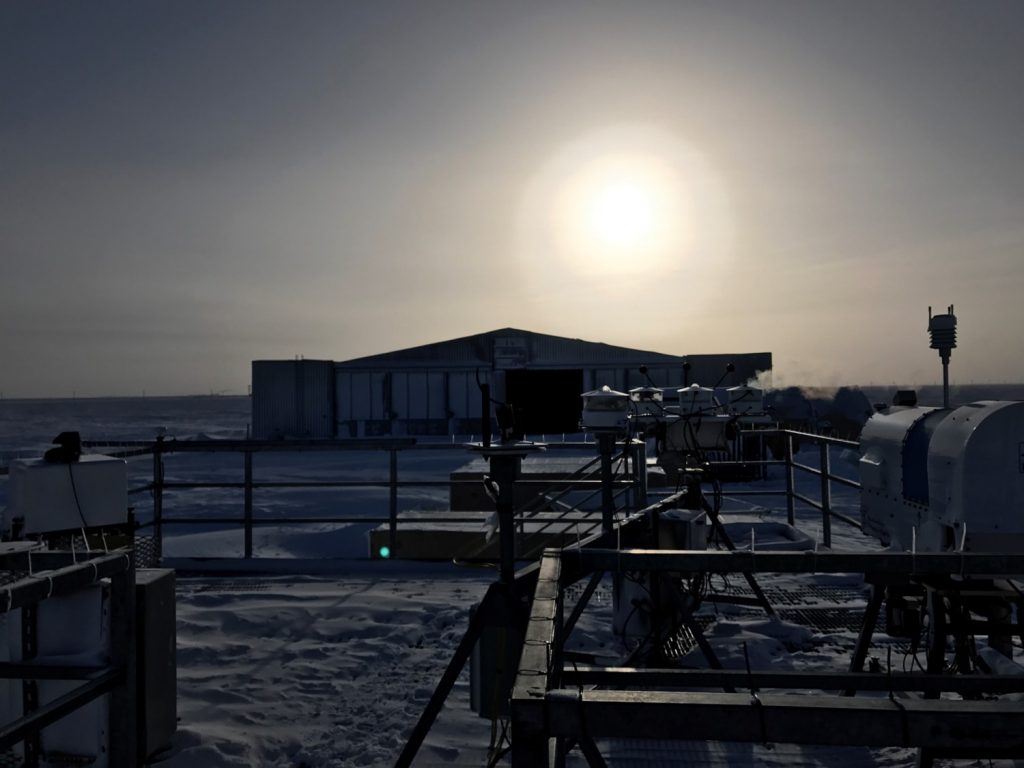
Looks like the afternoon, right? This photo was actually taken at 11:30 believe it or not. The sun has crazy angles this time of year! This photo was also taken on top of the instrument deck facing the hanger at the site.
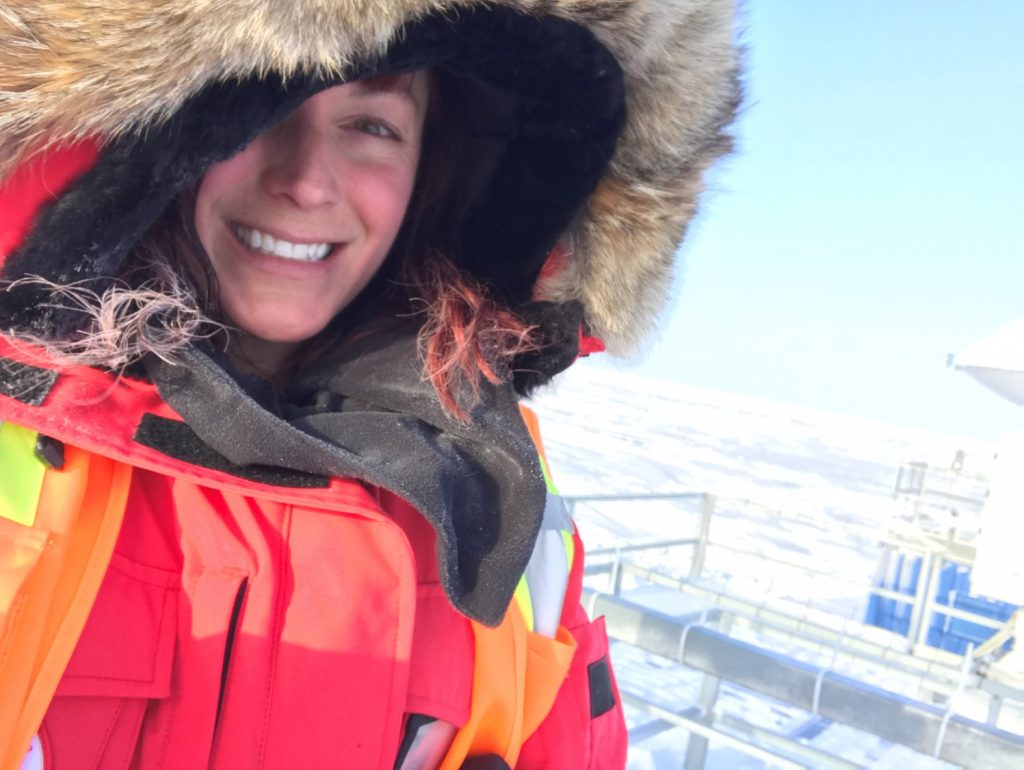
Beautiful blue bird day! I was a happy camper, complete with half frozen hair 😀
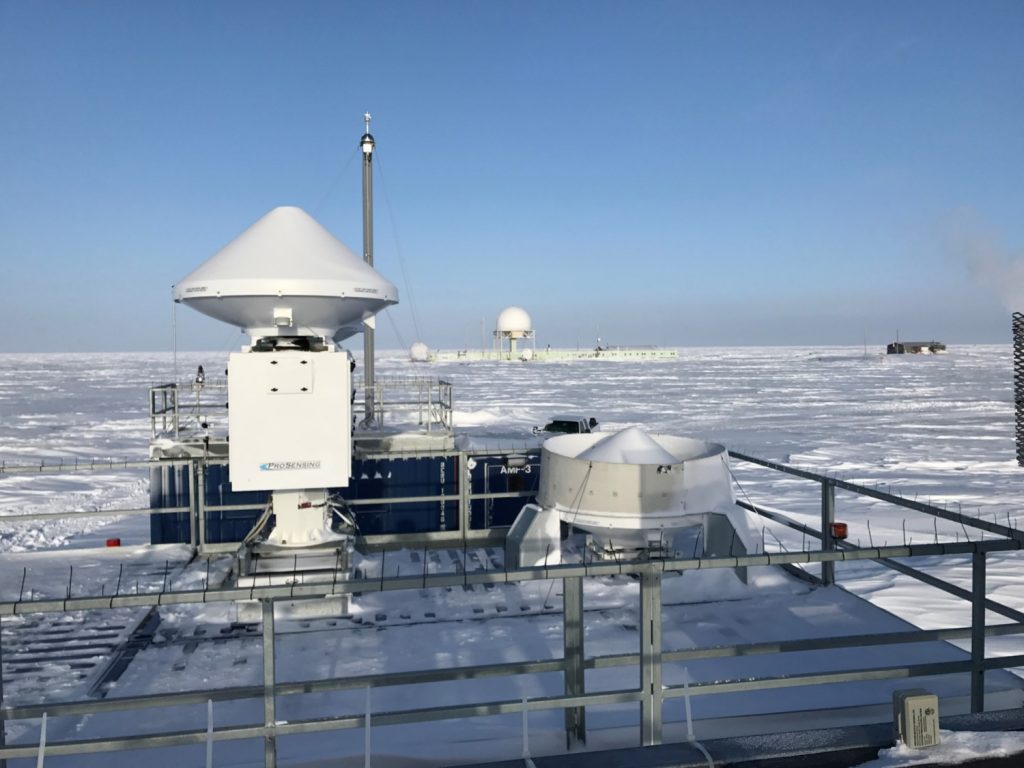
This is the view towards the Arctic Ocean, which as you can probably tell, is completely covered by ice this time of year. Those weird shaped white things in the photo are different kinds of radars to look at clouds and precipitation.
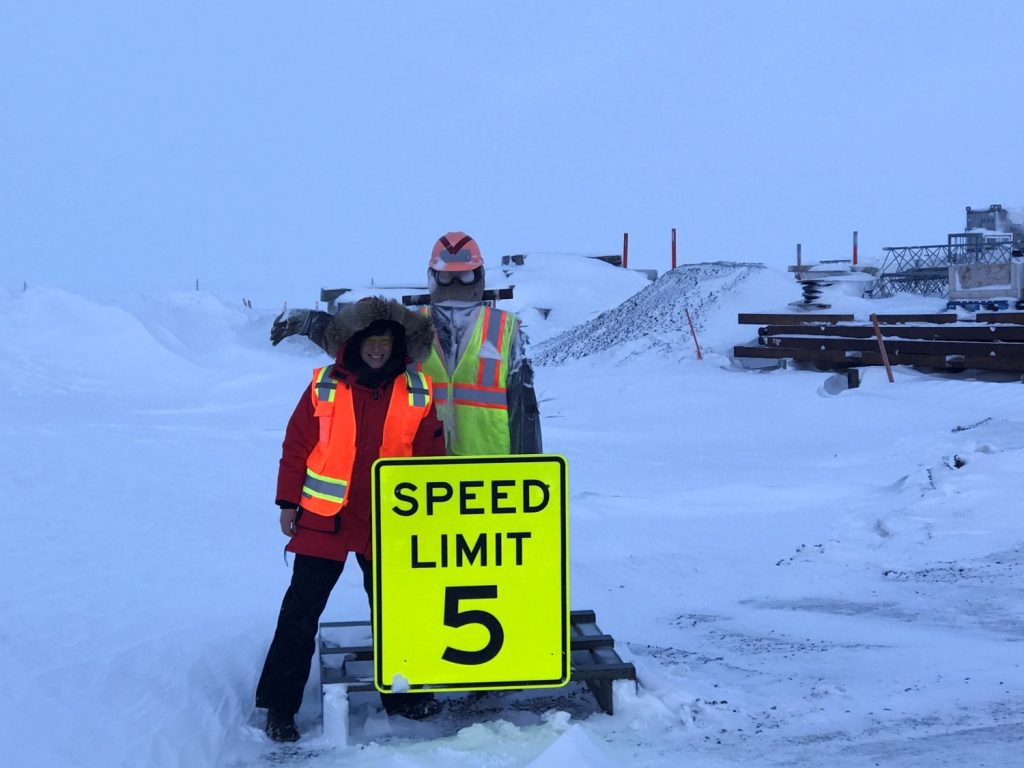
This is Harold. He makes sure you abide by the speed limit when entering camp (called the “NOC”, which stands for Nikaitchuq Operations Camp operated by ENI Petroleum).

And finally, CHEESEBURGER NIGHT at the mess hall! Complete with curly fries and a Nutella milkshake!


This sounds so interesting BUT, too dangled cold!!!! Brrrrrrrr!
☃️☃️☃️☃️
Love you, Aunt Barb
Haha, thanks Aunt Barb! Love you too!
Hey Jessie,
Comments/questions from my AM class. About how cold is it there in the winter compared to the summer? Do you like the meals so far? How many people live there right now, and how many year round. How strong are the winds? How many people are in a bunker? Good luck on finding that polar bear! Quin says, “Bring one back on the plane!” haha
Aunt Linda
Hi Aunt Linda and AM class!
In the winter with the winds, it can reach temperatures as low as -73 degrees F, sometimes even lower if it is really windy and cold. In the summer, there is actually no snow here in northern Alaska and it can be pretty warm (in the 50’s). There are actually a lot of mosquitos here in the summer, but also a lot of cool wildlife like caribou, musk oxen, polar bears, and even grizzly bears.
The meals are excellent! We have had steak, burgers, lamb, fish, chicken, all kinds of veggies, salad, and a ton of different desserts. Yum! The cooks and bakers do a great job here keeping us fed well.
There are a lot of different people working up here, including the oil workers, cooks and housekeeping, guards, air force workers, and scientists. Not many people actually live here permanently, what happens is most of the routine workers here do 1-3 week shifts, then go home for some time, then come back and do another 1-3 weeks, and so on. Some people even have 3 month shifts! Everyone seems to have their own schedules. Right now, there are maybe 50-100 people here, but the camp (or bunker) I am staying at can hold several hundred people. Scientists like me come up when we have a field experiment we want to do, and so our time up here depends on how long we need to be up here to collect samplers and make sure our equipment is running well. For example, I am here for almost 3 weeks, but my sampler will be here for 3 months. Before I leave, I teach the science site technicians how to check on my samplers, so they take over after I get everything up and going. After the study ends, they send the samplers back to me so I can see what they collected using equipment back in my lab.
Since I have been here, the winds have reached about 45 mph! The last couple of days, they have been about 15-25 mph. But they can be even stronger if a large front moves through. I will be sure to post a video of the snow blowing soon so you can see 🙂
Thank you! Have not seen one yet, but hopefully I will. Haha thank you for the comment Quin, if one got on a plane, it would take up a whole row! They are HUGE bears, their shoulders can be 4-5 FEET tall! On their hind legs, they are typically over 6 feet tall and the largest one found up here was 11 feet tall! YIKES!
Jessie
Dr. Jessie,
Here are some comments/questions from my P.M. class. What kind of vehicle do you use to get to the site? What is the worst thing you have ever have happen to you while being a scientist? What do you do in your spare time? Have you seen a snowy owl or snow hare? Do the people that stay there year round celebrate holidays? Do they have snow mobiles you can use? How many people are there? Ava hopes one day she can go to explore the Arctic. Kegan says the burger looks delicious. Sophia hopes you are having a great time. Maddie says you look great in the pictures. Leah says it looks cold, but fun!
Hi Aunt Linda and PM class!
To get to the site, we have to drive a REALLY large pickup truck. The road to the site has to be plowed with a front loader or bulldozer quite a bit because the snow blows so much here, it creates large, impassible drifts in the road. Sometimes if it is really bad, you have to use a snow cat!
The worst thing that has happened to me while being a scientist…hmmm, that is a tough one. I love my job! And even the worst experiences teach you something. For example, my very first field experiment I went on in graduate school was in Atlanta, GA. The sampler I was working with to collect aerosols and tell us the chemistry of those aerosols was very large (800 lbs) and very expensive (about $500,000). I had an electrical issue with it overnight one night, while I was not at the site, and through I had destroyed the entire instrument. After returning from the field experiment, I worked for months in lab to fix everything that was wrong with it. Finally, I got it working! Although it took a lot of time and effort to fix, I learned a lot about circuitry, low pressure systems, electronics, and lasers. It was actually a really good experience. It also taught me to look at the bright side. Even though things went very wrong during the study, I still collected data and was able to write a chapter in my thesis about how hurricanes bring sea salt alllll the way to Atlanta, and how those sea salt particles impacted the clouds in Atlanta. It turned out to be a great experience. Anytime something bad happens with my research, or if something does not go the way I would hope, I still learn something from that experience. Science is an amazing field, you are always learning something new and interesting, no matter what the situation is!
There is a great gym here, so in my spare time I try to exercise. I have to work off all that delicious food they are cooking for us 😉 They also have a sauna that I hope to use. Sometimes I am tired from working, so I will relax and watch a movie. It is quite nice!
I have not seen a snowy owl or snow hare, but I have heard that at the other site up here, called Utqiagvik (it is 200 miles west of here along the coast), they have seen snowy owls there.
This camp and our science site operates 24/7, 365 days a year. So some people do have to work here on the holidays. Those are very dedicated folks! There are a lot of different people working up here, including the oil workers, cooks and housekeeping, guards, air force workers, and scientists. Not many people actually live here permanently, what happens is most of the routine workers here do 1-3 week shifts, then go home for some time, then come back and do another 1-3 weeks, and so on. Some people even have 3 month shifts! Everyone seems to have their own schedules. So any one person does not have to stay up here for all of the holidays in any given year luckily. I am sure the people who are working during the holidays do celebrate up here!
There are snow mobiles here, but they are only used when necessary (not really used for fun). More for emergencies. It is so cold with the wind already, I am not sure how fun it would be to ride around out there with even more wind blowing in your face 🙂
Right now, there are maybe 50-100 people here, but the camp I am staying at can hold several hundred people. Scientists like me come up when we have a field experiment we want to do, and so our time up here depends on how long we need to be up here to collect samplers and make sure our equipment is running well.
Ava, you would have a blast up here! I hope you do pursue your dream to explore the Arctic, it is truly an amazing and bizarre place. With the climate changing as fast as it is, the Arctic is changing almost twice as much as the rest of the planet. The warm air melts the snow and ice faster, and because the tundra and ocean are not as reflective as the white snow and ice surface, they create even more heat from the sun, especially during the summer. So, that means the Arctic warming is amplified because of that added heat. We need more scientists like you to come up here and understand what is going on!
Kegan, they certainly are delicious! I had two that night, needless to say I was very full 🙂
Sophia, thank you very much! I am having a great time. I am glad you guys are following my blog, I hope you are learning a lot and are as excited about Arctic science as I am!
Maddie, thank you so much! I try to take the best pictures possible, sometimes they do not turn out so well if a gust of wind blows in my face, brrrrrr.
Leah, it is indeed cold! But all that gear I wear is specially made for working in the Arctic. My parka feels like I am wearing 4 sleeping bags around me at once! They gear is very warm and definitely helps from getting too cold. When I am outside and am trying to take pictures, I have to take off my gloves because they are so big and warm. But then my hand starts to freeze within seconds, it is crazy how fast exposed skin starts to hurt from the cold!
Jessie
It looks like you are on another planet, the only exception would be the Cheese Burgers. Very interesting air sampling techniques, the equipment must be very durable to put up with those temps and winds. Stay warm my little Scientist……..
Haha it sure does, that is exactly what I thought the first time I came up here last year. Will try to stay warm! 🙂
Jessie,
It’s amazing the weather conditions you have to endure! I can’t believe that your hair actually froze. I enjoyed your sample collection info. Great job and warm thoughts.
Love, Barb P
Thanks Barb! It really isn’t so bad with all the warm gear on. You’ll have to try on my parka when you guys visit this summer and you will see how I stay warm 😉
Jessie,
Can you Skype Friday? I was wondering if you can do it in two groups. I have 54 kids and can’t fit in my side of the trailer I’m teaching in. Let me know if it works. Kids VERY excited!
We have had some issues with power at the site the last few days, so I am hoping I will be able to Skype with your classes tomorrow! What times exactly? 10:00 central time will most likely work, since that is 8:00 here (I should be at the site). What time would your other class be able to Skype? I can be here at the site from 9:30-14:00 central time.
Jessie,
Looks like you are settling in well. Hope your experiments work well.
Please tell Fred Hi from me. He and I shared experiences in a much warmer part of the world a couple of decades ago.
Paul
Hi Paul, glad you are checking out my blog. Fred says hello back, he was happy to hear from you!